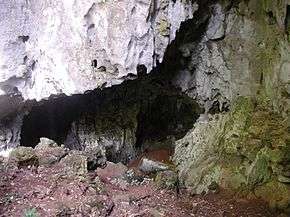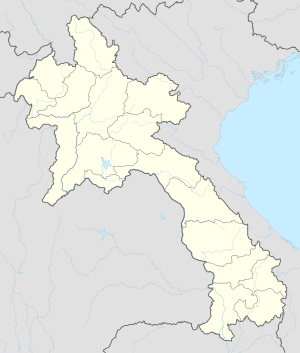Tam Pa Ling Cave
 South entrance to the cave | |
 location in Laos | |
| Alternate name | Cave of the Monkeys |
|---|---|
| Location | Houaphanh Province, northern Laos 260 km (160 mi) NNE of Vientiane |
| Region | Annamite Mountains |
| Coordinates | 20°12′31″N 103°24′35″E / 20.20861°N 103.40972°ECoordinates: 20°12′31″N 103°24′35″E / 20.20861°N 103.40972°E |
| Type | Cave |
| Part of | Pa Hang Mountain |
| Length | 40 m (130 ft) |
| Width | 30 m (98 ft) |
| History | |
| Material | limestone, karst |
| Periods | Upper Paleolithic, Middle Paleolithic |
| Associated with | Paleo-humans |
| Site notes | |
| Excavation dates | 2008 to current |
Tam Pa Ling (Cave of the Monkeys) is a cave in the Annamite Mountains in north-eastern Laos. It is situated at the top of Pa Hang Mountain, 1,170 m (3,840 ft) above sea level.
Two hominin fossils have been discovered in the cave: 'TPL1', a skull belonging to an anatomically modern human; and 'TPL2', a mandible with both modern and archaic traits. The fossils represent two separate individuals and are between 46,000 and 63,000 years old. The discoveries definitively established that modern humans had migrated to Southeast Asia by at least 60,000 BP.[1][2]
Location and geology
Tam Pa Ling has a single, south-facing opening and descends 65 m (213 ft) to its main gallery. It is part of a network of karst caves, formed by the dissolution of limestone beds that were laid down between the Upper Carboniferous and Permian periods. The main gallery measures 30 m (98 ft) from north to south and 40 m (130 ft) from east to west.[3]
Fossils
Excavations at the eastern end of the cave's main gallery, at the base of the sloped entrance, were conducted by a team of American, French and Laotian researchers starting in 2009.[4][5]
The first fossil find, a hominin skull dubbed 'TPL1', was recovered at a depth of 2.35 m (7 ft 9 in) in December 2009. A mandible, 'TPL2', was found the following year at a depth of 2.65 m (8 ft 8 in). Radiocarbon and luminescence dating of the sediments established a minimum age of 51,000 to 46,000 years, and direct uranium-thorium dating of the fossils indicated a maximum age of 63,000 years.[5]
TPL1 includes the frontal, partial occipital, right parietal, and temporal bone, as well as the right and left maxillae and a largely complete dentition. It was identified as belonging to an anatomically modern human with distinct Sub-Saharan African features. As of 2016, it provides the earliest skeletal evidence for the presence of Homo sapiens in mainland Southeast Asia.[6]
The TPL2 mandible was found lower down in the same stratigraphic unit as TPL1, and represents a mature adult that combines archaic human features such as a robust mandibular corpus and small overall size, with modern human traits like a developed chin.[6][7]
Significance
The timing of modern human migration from Africa to East Asia is not known with certainty; because bone is poorly preserved in tropical climates, human fossils from the region are rare. Recent discoveries in China, the Philippines, Sri Lanka and Australia had previously established that archaic human fossils were present between 125,000 and 100,000 BP, and those of modern humans from about 40,000 BP. The discovery of the fully modern TPL1 specimen was therefore considered a major discovery because it filled in a 60,000-year gap in the fossil record, demonstrating the presence of modern humans in Southeast Asia from at least 60,000 BP. Additionally, as Tam Pa Ling lies a thousand miles inland, the finds challenged previous assumptions that humans migrated out of Africa by following coastlines. They suggest that the migration may also have proceeded along river valleys, which served as natural corridors through the continent.[8]
The fossils were temporarily removed to the United States for study by paleoanthropologist Laura Shackleford, Fabrice Demeter and the team. In April 2016 they were returned to Laos, and are now housed in a new building of the Lao National Museum in Vientiane.[9]
See also
References
- ↑ "Cave of the Monkeys: Photos Reveal Early Modern Human Remains". Live Science. August 20, 2012. Retrieved August 21, 2016.
- ↑ "Tam Pa Ling". Anthropology Net. April 11, 2015. Retrieved August 21, 2016.
- ↑ "Anatomically modern human in Southeast Asia (Laos) by 46 ka" (PDF). National Academy of Sciences. July 23, 2012. Retrieved August 23, 2016.
- ↑ Shackelford, Laura. "Finding a Home for the Bones of Tam Pa Ling". Illinois News Bureau. University of Illinois Urbana-Campaign. Retrieved 2016-08-21.
- 1 2 "Ancient Human Fossils from Tam Pa Ling, Laos". Anthropology Net. April 11, 2015. Retrieved August 21, 2016.
- 1 2 "Early Modern Humans and Morphological Variation in Southeast Asia: Fossil Evidence from Tam Pa Ling, Laos". PLOS ONE. April 7, 2015. Retrieved August 21, 2016.
- ↑ "The Woman from Tam Pa Ling". Public Broadcasting Service (PBS). Retrieved August 21, 2016.
- ↑ "Oldest bones from modern humans in Asia discovered". CBSNews. August 20, 2012. Retrieved August 21, 2016.
- ↑ "Bringing home the bones of Tam Pa Ling". Research News Bureau ILLINOIS. April 13, 2016. Retrieved August 21, 2016.